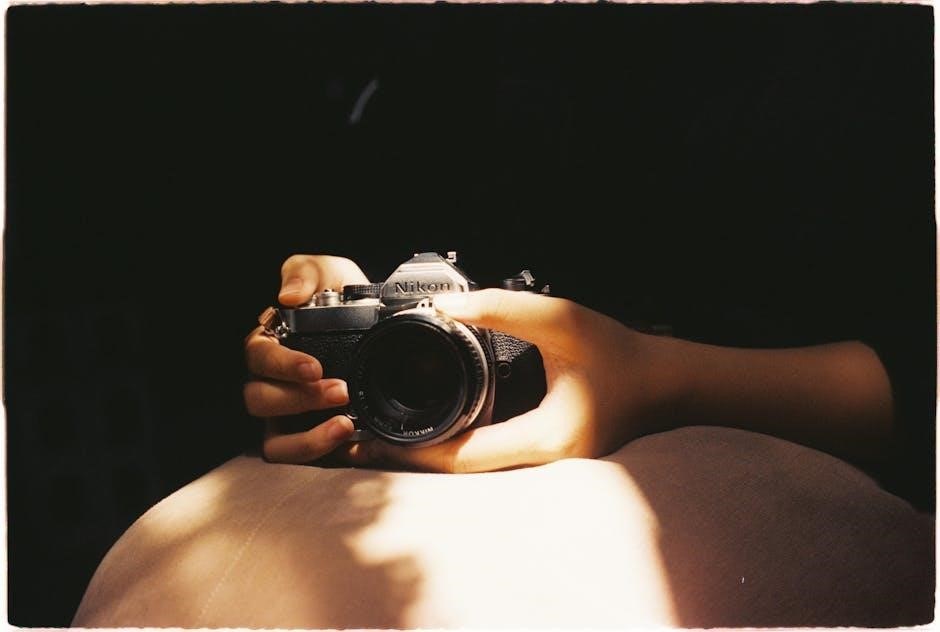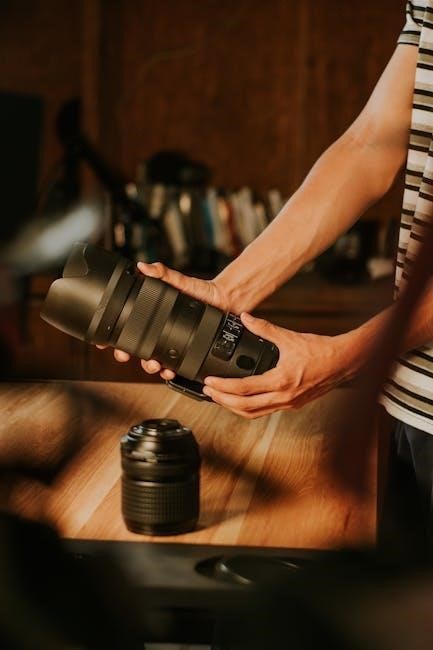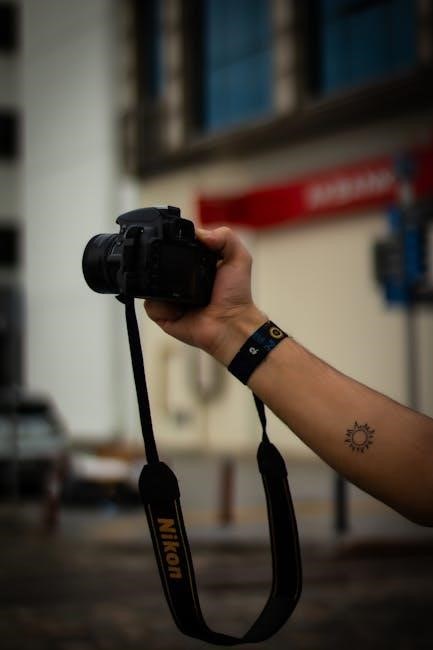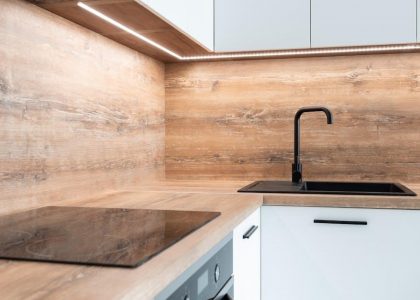The Nikon D810 instruction manual is a comprehensive guide designed to help users master the camera’s advanced features. It covers everything from basic setup to detailed shooting modes, ensuring photographers can unlock the full potential of their equipment. The manual is available for download as a PDF, making it easily accessible for reference anytime, anywhere.
Overview of the Nikon D810 Camera
The Nikon D810 is a high-performance DSLR camera designed for professional photographers and enthusiasts. It features a 36.3-megapixel FX-format CMOS sensor, delivering exceptional image quality with precise detail and rich tonal range. The camera offers a wide ISO sensitivity range of 64-12800, enabling superb low-light performance. With a continuous shooting speed of up to 7 FPS, it excels in capturing fast-moving subjects. The D810 also includes a 3.2-inch LCD screen with color adjustment for accurate image preview and review. Built for durability, it is crafted with a weather-sealed magnesium alloy body, ensuring reliability in challenging environments. This camera is a powerful tool for capturing stunning stills and videos, making it a favorite among professionals and serious photographers.
Purpose and Scope of the Instruction Manual
The Nikon D810 instruction manual serves as a detailed guide to understanding and utilizing the camera’s features effectively; Its purpose is to provide clear, step-by-step instructions for setting up, operating, and customizing the camera. The manual covers essential functions, advanced settings, and troubleshooting tips, ensuring users can maximize the camera’s capabilities. It also includes information on accessing additional resources, such as software downloads and firmware updates, to keep the camera up-to-date and functioning optimally; The manual is designed to cater to both novice and experienced photographers, offering comprehensive support for every aspect of camera operation.

Key Features of the Nikon D810
The Nikon D810 boasts a 36.3-megapixel FX-format CMOS sensor, 3.2-inch LCD, continuous shooting up to 7 FPS, and a wide ISO sensitivity range, making it versatile for various photography needs.
Technical Specifications
The Nikon D810 features a 36.3-megapixel FX-format CMOS sensor, delivering exceptional image quality. It is powered by the EXPEED 4 image-processing engine, enhancing speed and accuracy. The camera supports 51 autofocus points for precise subject tracking and offers a wide ISO range of 64-12800, expandable to 32-51200. It can shoot continuously at up to 7 frames per second in full resolution and features a 3.2-inch, 1.23M-dot LCD with color adjustment. The D810 also records Full HD 1080p video at 60/50/30/25/24p and supports external audio recording.
36.3 Megapixel FX-Format CMOS Sensor
The Nikon D810 is equipped with a 36.3-megapixel FX-format CMOS sensor, designed for exceptional image quality. This sensor captures intricate details and offers wide dynamic range, ideal for professional photography. The FX format ensures compatibility with a wide range of NIKKOR lenses, maximizing optical performance. The sensor’s design minimizes noise and enhances color accuracy, providing outstanding results in both bright and low-light conditions. This feature makes the D810 a versatile and powerful tool for photographers seeking high-resolution images with precise clarity and depth.
3.2-Inch LCD Screen with Color Adjustment
The Nikon D810 features a 3.2-inch LCD screen with advanced color adjustment capabilities. This high-resolution display provides vivid previews of images and videos, ensuring precise color representation. The screen’s wide viewing angle and brightness settings make it suitable for shooting in various lighting conditions. Users can adjust color balance and tone to match their creative vision, enhancing workflow efficiency. This feature is particularly useful for reviewing shots and making on-the-spot adjustments, ensuring optimal results in both still photography and video recording. The LCD screen is a key tool for achieving professional-grade imagery with the D810.
Continuous Shooting Speed Up to 7 FPS
The Nikon D810 offers a continuous shooting speed of up to 7 frames per second (FPS), making it ideal for capturing dynamic action and fast-moving subjects. This feature is particularly useful for sports, wildlife, and event photography, where timing is critical. The camera’s advanced buffer allows for extended bursts, even when shooting in RAW format. With this speed, photographers can freeze moments with precision, ensuring sharp and well-timed images. The D810’s performance in continuous shooting mode enhances workflow efficiency for professionals and enthusiasts alike, delivering reliable results in demanding situations.
Wide ISO Sensitivity Range
The Nikon D810 features an exceptional ISO sensitivity range of 64 to 12,800, which can be further expanded to 32 or 51,200 for extreme low-light conditions. This wide range ensures optimal performance in various lighting environments, from bright landscapes to dimly lit interiors. The camera’s advanced noise reduction capabilities maintain image quality even at higher ISO settings, delivering sharp and detailed results. This flexibility makes the D810 a versatile tool for photographers seeking to capture stunning images in diverse lighting scenarios without compromising on quality.

Getting Started with the Nikon D810
Unpack and familiarize yourself with the camera and its accessories. Follow the initial setup guide to configure basic settings and understand the camera’s layout for optimal use.
Unpacking and Accessories
When unpacking your Nikon D810, carefully inspect all items to ensure they are included and undamaged. The package typically includes the camera body, battery, charger, USB cable, and shoulder strap. Additional accessories like lenses, memory cards, and external microphones may be purchased separately. Before use, charge the battery fully and familiarize yourself with each component. Refer to the manual for detailed descriptions and setup instructions to ensure proper installation and configuration of all accessories.
First-Time Setup and Initial Configuration
Upon first use, insert the battery and memory card, then power on the camera. Set the language, time zone, and date using the Setup Menu. Familiarize yourself with basic settings like image quality, white balance, and autofocus modes. Customize the camera to your preferences by adjusting settings such as ISO sensitivity and shooting modes. Refer to the manual for step-by-step guidance to ensure proper configuration and optimal performance. This initial setup lays the foundation for capturing stunning images with your Nikon D810.
Understanding the Camera Layout
Familiarizing yourself with the Nikon D810’s layout is essential for efficient operation. The camera features a robust ergonomic design with intuitive controls. Key components include the mode dial, shutter release button, and multi-selector for navigation. The 3.2-inch LCD screen and optical viewfinder provide excellent visibility. Memory card slots, battery compartment, and ports for external accessories are strategically located. Understanding the placement of buttons like the i button, which offers quick access to settings, and the live view switch will enhance your shooting experience. This layout ensures easy access to essential functions, optimizing your workflow during photography sessions.

Shooting Modes and Settings
The Nikon D810 offers a variety of shooting modes, including Manual, Aperture Priority, Shutter Priority, and Auto modes, providing flexibility for different photography scenarios and creative control.
Mode Descriptions and Selection
The Nikon D810 offers a range of shooting modes, each tailored for specific photography needs. Manual Mode provides full control over aperture, shutter speed, and ISO, ideal for experienced photographers. Aperture Priority allows users to set the aperture while the camera adjusts the shutter speed. Shutter Priority is perfect for capturing motion by setting the shutter speed. Auto Mode simplifies photography by automatically adjusting settings. Additionally, the camera features Scene Modes like Portrait, Landscape, and Sports, which optimize settings for specific scenarios. Users can easily select modes via the mode dial or menu, ensuring versatility and creativity in various shooting conditions.
Custom Shooting Modes and Presets
The Nikon D810 allows users to save custom shooting settings as personalized modes, enabling quick access to preferred configurations. These modes can be tailored for specific scenarios, such as portrait, landscape, or action photography. Users can store settings like aperture, shutter speed, ISO, and white balance in the camera’s memory. The custom modes are accessed via the mode dial, making it easy to switch between setups. This feature enhances workflow efficiency and ensures consistent results across different shooting conditions, catering to both amateur and professional photographers seeking precision and flexibility.
Advanced Scene Modes
The Nikon D810 offers advanced scene modes designed to optimize settings for specific photography scenarios. Modes like Low Light, Portrait, and Landscape automatically adjust parameters such as aperture, shutter speed, and ISO for ideal results. These modes are particularly useful for capturing high-quality images in challenging conditions. Additionally, the camera’s Scene Auto Selector intelligently detects the environment and adjusts settings accordingly. These features are beneficial for photographers of all skill levels, providing flexibility and enhancing creativity while ensuring optimal image capture in various lighting and compositional situations. The D810’s advanced scene modes simplify complex photography tasks, delivering professional-grade results effortlessly.

Custom Settings and Personalization
The Nikon D810 allows extensive customization to tailor camera settings to individual preferences. Users can adjust autofocus, metering modes, and button assignments for personalized control. Custom Shooting Modes enable saving favorite settings for quick access, enhancing workflow efficiency; The camera’s flexibility ensures photographers can adapt it to their unique style and shooting requirements, making it a versatile tool for creative expression and professional-grade photography. These customization options empower users to maximize the D810’s capabilities and achieve their artistic vision with precision and ease.
Customizing Camera Settings
The Nikon D810 offers extensive customization options to tailor camera settings to individual preferences. Users can adjust autofocus modes, metering options, and button assignments for personalized control. The camera allows saving custom settings to memory slots (U1, U2, U3) for quick access during different shooting scenarios. Additionally, the i button provides rapid access to frequently used settings, streamlining workflow. These customization features enable photographers to adapt the camera to their unique shooting style, ensuring efficient and intuitive operation. This level of personalization enhances creativity and precision, making the D810 a versatile tool for professionals and enthusiasts alike.
Using the i Button for Quick Access
The Nikon D810’s i button provides instant access to frequently used settings, enhancing workflow efficiency. Pressing the i button displays a customizable menu where users can quickly adjust settings like ISO, AF-mode, and white balance. This feature allows photographers to make adjustments without navigating through complex menus, saving valuable time during shoots. The i button can also be customized to prioritize the most commonly used functions, further streamlining camera operation. This intuitive tool is designed to keep the shooting process smooth and uninterrupted, ensuring photographers never miss a moment.
Configuring Autofocus and Metering
Configuring autofocus and metering on the Nikon D810 ensures precise control over focus acquisition and exposure. The camera offers multiple autofocus modes, including Single AF and Continuous AF, which can be customized based on the subject’s movement. Metering modes, such as Matrix, Center-weighted, and Spot, allow for accurate exposure calculations. Users can adjust these settings via the camera’s menu system or using the multi-selector and AF-ON button for quick access. Customizing these features enhances the camera’s responsiveness and ensures optimal results in various shooting conditions.
Advanced Features of the Nikon D810
The Nikon D810 offers advanced features like RAW image capture, white balance adjustment, and bracketing for HDR shooting, enhancing creative control and image quality. Additional movie recording capabilities further expand its versatility for videographers and photographers alike.
RAW Image Capture and Processing
The Nikon D810 supports RAW image capture, enabling photographers to retain maximum image data for post-processing. Shooting in RAW format allows for greater flexibility in adjusting exposure, color balance, and noise reduction without compromising image quality. The camera also supports simultaneous recording of RAW and JPEG files, catering to both professional and amateur needs. Additionally, Nikon’s software tools provide robust solutions for editing and managing RAW files, ensuring optimal results in various lighting conditions and creative scenarios.

White Balance and Color Temperature Adjustment
The Nikon D810 offers precise white balance and color temperature controls, ensuring accurate color reproduction in various lighting conditions. Users can choose from preset options like Auto, Daylight, Fluorescent, and Cloudy, or manually set a custom white balance. The camera also allows for fine-tuning color temperature in Kelvin, providing flexibility for creative adjustments. Additionally, the optional color temperature adjustment feature enables photographers to achieve consistent colors across images, enhancing the overall quality and visual appeal of their work in different environments.
Bracketing and HDR Shooting
The Nikon D810 supports advanced bracketing and HDR shooting, allowing photographers to capture a wide dynamic range. The camera offers automatic exposure bracketing, shooting up to 9 frames at intervals of 1/3 to 2 EV. HDR (High Dynamic Range) mode combines these images in-camera, producing a single photo with enhanced contrast and detail. For optimal results, use a tripod to ensure alignment and minimize movement. This feature is particularly useful for landscapes, interiors, and high-contrast scenes, enabling photographers to preserve both highlight and shadow details effectively.
Movie Recording and Video Features
The Nikon D810 excels in video recording, offering full HD at 60p and manual controls for exposure and audio. Its auto ISO mode enhances filming convenience while maintaining quality.
Video Shooting Modes and Settings
The Nikon D810 offers versatile video shooting modes, including manual (M), aperture-priority (A), and shutter-priority (S) modes, allowing precise control over exposure. It supports full HD video at 60p, 30p, and 24p frame rates, ensuring smooth motion and cinematic results. Users can adjust ISO sensitivity, shutter speed, and aperture during recording for enhanced creativity. The camera also features an auto ISO mode in manual video settings, simplifying exposure adjustments. Additional settings include focus tracking, audio controls, and the option to record in DX crop mode for extended reach. These features make the D810 ideal for professional-grade video production.

Focus Modes for Video Recording
The Nikon D810 offers advanced focus modes for video recording, ensuring precise control over your footage. Single-servo AF (AF-S) mode is ideal for stationary subjects, while continuous-servo AF (AF-C) mode excels at tracking moving subjects. Manual focus (MF) mode provides direct control for creative adjustments. The camera also features face detection and subject-tracking options, enhancing focus accuracy during recording. These modes, combined with customizable settings, allow filmmakers to achieve professional-grade focus in various video production scenarios, ensuring sharp and dynamic results.
Audio Controls and External Microphone Options
The Nikon D810 provides robust audio controls for high-quality video recording. It features manual audio level adjustments, allowing precise control over sound capture. The camera supports external microphones via its 3.5mm stereo jack, enabling clearer and more professional audio. Additionally, the optional ME-1 stereo microphone can be connected for enhanced sound quality. These features ensure that filmmakers can achieve excellent audio synchronization with their video, making the D810 a versatile tool for multimedia production and storytelling.

Connectivity and Data Transfer
The Nikon D810 offers wireless connectivity options for seamless image transfer to compatible devices. It supports direct connection to computers via USB for efficient data transfer. Additionally, Nikon software tools enable organized image management and editing, enhancing the overall workflow for photographers. These features ensure convenient sharing and post-processing of high-quality images captured with the D810.
Wireless Connectivity Options
The Nikon D810 supports wireless connectivity through built-in Wi-Fi and NFC, enabling easy image transfer to smartphones, tablets, and computers. Using Nikon’s free Wireless Mobile Utility app, users can remotely control the camera and share photos instantly. This feature is ideal for on-the-go photographers who need to upload content quickly. Additionally, the camera’s wireless capabilities streamline workflow, allowing for direct backups and social media sharing. This functionality enhances the camera’s versatility and convenience for professional and amateur photographers alike.
Transfering Images to a Computer
Transferring images from the Nikon D810 to a computer can be done via USB or by using a memory card reader. Connect the camera directly using the supplied USB cable, or insert the memory card into a compatible reader. Nikon’s Transfer software, part of the ViewNX package, allows easy import of photos to your computer. Additionally, wireless transfer is possible using the Wireless Mobile Utility app. Ensure the camera and computer are connected to the same network for seamless file transfer. Refer to the manual for detailed steps and software installation guides.
Using Nikon Software for Image Management
Nikon provides dedicated software for managing and enhancing images captured with the D810. ViewNX allows users to browse, edit, and share photos, while Capture NX offers advanced editing tools for RAW files. Additionally, Camera Control Pro enables remote camera operation and image transfer. These tools streamline workflow, ensuring efficient organization and optimization of images. Refer to the manual for installation and usage instructions to maximize the potential of Nikon’s software suite.

Maintenance and Care
Regular maintenance ensures the Nikon D810 performs optimally. Clean the camera and lens frequently, store it in a dry, cool place, and handle with care to prolong its lifespan.
Cleaning the Camera and Lens
Regular cleaning of the Nikon D810 and its lens is essential for maintaining image quality. Use a soft, dry cloth to wipe the camera body and lens surfaces. Avoid harsh chemicals or abrasive materials that may damage the coatings. For the mirror and image sensor, use a blower or specialized cleaning tools to remove dust gently. Smudges on the lens should be cleaned with a microfiber cloth and lens cleaning solution. Always refer to the manual for detailed cleaning instructions to prevent damage and ensure optimal performance.
Battery Maintenance and Charging
To ensure optimal performance, use only Nikon-approved chargers and batteries for the D810. Avoid overcharging, as it can reduce battery life. Store batteries in a cool, dry place away from metal objects. If not using the battery for an extended period, charge it to 50% and check its charge level every six months. Clean terminals with a soft cloth to maintain proper connections. Refer to the manual for detailed guidelines on charging, storage, and extending battery longevity to keep your camera powered and ready for use.
Storage and Travel Tips
For proper storage, keep the Nikon D810 in a cool, dry place away from direct sunlight. Use original Nikon cases or protective gear to prevent damage. When traveling, pack the camera securely in a sturdy bag with padding. Consider using silica gel packets to absorb moisture. Always carry extra batteries and memory cards in a separate, organized pouch. Keep the camera manual easily accessible for quick reference. When shooting in harsh environments, clean the camera and lenses regularly to prevent dust buildup. Minimize lens changes in dusty conditions to maintain image quality during your travels.

Troubleshooting Common Issues
Troubleshooting common issues with the Nikon D810 involves identifying error messages and applying appropriate solutions. This section provides a concise guide to resolving operational problems effectively.
Resolving Error Messages
Resolving error messages on the Nikon D810 is crucial for uninterrupted photography. The manual provides detailed explanations of each error code, such as “ERR” or “CARD FULL,” and offers step-by-step solutions. Users can also reset settings to default or update firmware to fix issues. Additionally, Nikon’s support resources are available online for further troubleshooting. Regularly checking for firmware updates ensures optimal camera performance and minimizes errors. This section helps users quickly address and resolve common issues, ensuring smooth operation during photo shoots.
Common Problems and Solutions
The Nikon D810 instruction manual addresses common issues photographers may encounter. For instance, camera freezing can often be resolved by performing a reset or updating the firmware. Poor image quality may result from incorrect settings, which can be fixed by adjusting the ISO or white balance. Lens errors can be resolved by cleaning the lens or checking its alignment. Additionally, SD card errors can be addressed by formatting the card or using a high-quality alternative. These solutions ensure smooth operation and optimal performance of the camera.
Updating Firmware
Updating the firmware on your Nikon D810 is essential for maintaining optimal performance and accessing new features. Visit Nikon’s official website to download the latest firmware version. Use a card reader to transfer the firmware file to your memory card. Insert the card into the camera and follow the on-screen instructions to complete the update. Ensure the camera is fully charged and avoid interrupting the process. After the update, restart the camera to apply the changes. Regular firmware updates help resolve issues and enhance functionality. Refer to the manual for detailed steps and precautions.
The Nikon D810 instruction manual is your key to unlocking the camera’s full potential. By mastering its features and settings, you can achieve professional-grade photography with ease and precision.
Maximizing the Potential of the Nikon D810
To fully utilize the Nikon D810, explore its advanced features like RAW image capture, white balance adjustments, and HDR shooting. Experiment with custom settings and shooting modes to tailor the camera to your style. Regular firmware updates ensure optimal performance. Utilize the i-button for quick access to frequently used controls, enhancing your workflow; Practice with different autofocus and metering configurations to capture sharp, well-exposed images. By mastering these techniques, you can unlock the D810’s capabilities and achieve professional-grade results consistently.
Final Tips for Mastering the Camera
Download the Nikon Manual Viewer 2 app for easy access to the manual and explore resources like John Greengo’s guide for in-depth learning. Regularly update your firmware to ensure optimal performance. Experiment with different shooting techniques and practice using autofocus and metering modes. Familiarize yourself with custom settings and presets to streamline your workflow. For advanced control, use the i-button for quick adjustments. Finally, take advantage of Nikon’s software tools for image management and enhancement to fully unlock your D810’s potential and achieve professional results consistently.



